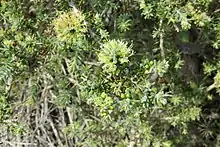| Melaleuca pomphostoma | |
|---|---|
 | |
| Scientific classification | |
| Kingdom: | Plantae |
| Clade: | Tracheophytes |
| Clade: | Angiosperms |
| Clade: | Eudicots |
| Clade: | Rosids |
| Order: | Myrtales |
| Family: | Myrtaceae |
| Genus: | Melaleuca |
| Species: | M. pomphostoma |
| Binomial name | |
| Melaleuca pomphostoma | |
Melaleuca pomphostoma is a plant in the myrtle family, Myrtaceae, and is endemic to the south-west of Western Australia. It is a small, dense shrub with fleshy, narrow leaves, greenish-yellow flowers. It is similar and closely related to Melaleuca bracteosa but differs in the colour and number of stamens in each flower.
Description
Melaleuca pomphostoma is a shrub which grows to about 1.5 m (5 ft) tall with thick, rough, slightly spongy grey bark. Its leaves are arranged alternately, glabrous, fleshy, 5–10 mm (0.2–0.4 in) long and 1–2 mm (0.04–0.08 in) wide and very narrow egg-shaped with a rounded end.[2]
The flowers are arranged in heads or short spikes containing 3 to 12 individual flowers, the spike about 20 mm (0.8 in) wide. They are greenish-yellow with the stamens arranged in five bundles around each flower, the bundles containing 11 to 18 stamens. The flowering season is in autumn and winter and is followed by fruit which are woody capsules 3.5–4 mm (0.1–0.2 in) long.[2][3][4]
Melaleuca pomphostoma is similar to Melaleuca bracteosa but differs from it in having fewer stamens (M. bracteosa has 7 to 11 per bundle), a different leaf shape and distinctive, numerous, white raised stomata, which are barely visible with a hand lens, on the leaf blades.[4]
Taxonomy and naming
Melaleuca pomphostoma was first formally described in 1992 by Bryan Barlow in Nuytsia as a new species.[5] The specific epithet (pomphostoma) is from the Ancient Greek words pomphos meaning "a blister"[6]: 624 and stoma meaning "mouth"[6]: 538 referring to the raised stomata on the lower leaf surface.[2]
Distribution and habitat
This melaleuca is confined to the Ravensthorpe district and the eastern end of the Fitzgerald River National Park[4] in the Esperance Plains biogeographic region[7] where it usually grows in sand or clayey loam[8]
Conservation
Melaleuca pomphostoma is classified as "not threatened" by the Government of Western Australia Department of Parks and Wildlife.[7]
References
- ↑ "Melaleuca pomphostoma". Plants of the World Online. Retrieved 5 September 2021.
- 1 2 3 Brophy, Joseph J.; Craven, Lyndley A.; Doran, John C. (2013). Melaleucas : their botany, essential oils and uses. Canberra: Australian Centre for International Agricultural Research. p. 289. ISBN 9781922137517.
- ↑ Holliday, Ivan (2004). Melaleucas : a field and garden guide (2nd ed.). Frenchs Forest, N.S.W.: Reed New Holland Publishers. p. 32. ISBN 1876334983.
- 1 2 3 Quinn, Frances; Cowley, Kirsten; Barlow, Bryan; Thiele, Kevin (1998). "New names and combinations for some Melaleuca (Myrtaceae) species and subspecies from the south-west of Western Australia considered rare or threatened" (PDF). Nuytsia. 8 (3): 343–345. Retrieved 17 April 2015.
- ↑ "Melaleuca pomphostoma". APNI. Retrieved 17 April 2015.
- 1 2 Brown, Roland Wilbur (1956). The Composition of Scientific Words. Washington, D.C.: Smithsonian Institution Press.
- 1 2 "Melaleuca pomphostoma". FloraBase. Western Australian Government Department of Biodiversity, Conservation and Attractions.
- ↑ Paczkowska, Grazyna; Chapman, Alex R. (2000). The Western Australian flora : a descriptive catalogue. Perth: Wildflower Society of Western Australia. p. 396. ISBN 0646402439.